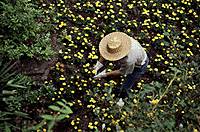Keep moose from eating trees and shrubs
Anchorage Daily News
Take steps to save cherished plants from first frost
JEFF LOWENFELS
GARDENING
(09/03/08 23:35:08)
Aw, do I have to write about saving plants from the doom of frost? I feel like Ann Landers copying former columns.
Well, the plants covered still form the backbone of many Southcentral gardens and I am getting too many questions on the subject to skip it, what with the cooler temperatures and the end of the Alaska State Fair.
Besides, this has become a tradition for the first column of September. This used to be because we had frosts Sept. 15, which we don’t seem to anymore.
But hush, lest I jinx it all.
So, here is the rule: Before frost, bring in pelargoniums, fuchsias, fibrous begonias and rhodochiton — if you want, of course. They do not do well when exposed to freezing temperatures.
Pelargoniums should be pulled, soil shaken off the roots, and then placed upside down in a bag in a cool, dark location. Next spring — no promises here — the roots will still be viable. On the other hand, you can keep them growing as houseplants and they will bloom in December if given good light, though not necessarily supplemental light and cool temperatures. You should cut them back to shape them now.
Fuchsias should be pruned into a pyramid shape, about 6 to 8 inches tall. This in anticipation of new shoots next spring from the remaining growth. Place them in the same dark, cool spot — say a crawl space or garage where the temperature never gets below 40 or above 50. Fuchsias, too, can be grown as houseplants if you provide cool enough temperatures, say in the low 50s. They will need supplemental light to flower.
All your tuberous begonias, dahlias and gladioli can take light frosts.
However, tuberous begonias do better with a much more gradual, indoor-induced dormancy, so if you have a chance take them into the garage in a week or two, stop watering and let the leaves and stems die back for a couple of weeks.
Then store the tubers in their containers with the fuchsias at 40 degrees.
Rhodochiton too can be wintered over, as can tuberous begonias, by leaving them in their original containers. Do collect any seeds that may have developed from some of the spent flowers. These can be planted early next spring as winter starts to fade.
I am leaving our dahlias in the ground for as long as I can while they are still flowering, something they just started doing. They are very late due to this year’s cool temperatures. They can take a few good hits of frost.
When you do decide to dig them up — and dig them up you should — you will find many tubers where once there was only one. Go wide with the spade. Shake off the soil, cut off the dead tops and label the stem of the plant of some of the tubers in each clump with a marker. Once again, put them in the proverbial cool, dark spot.
Gladioli can be dug after a frost. They may harbor mites and probably are not worth the while unless there is an unusual flower you wish to keep. You will find next year’s tuber under the one that produced this year’s growth. Guess where you should store them? In sawdust in that cool, dark spot.
Potatoes and brussels sprouts need a few frosts. Let them have it. They will taste better.
Notice I said better, obviously referring to brussels sprouts, my least favorite vegetable.
When it comes to vegetable and annual beds, now is the time to collect and lay down a good mulch of grass clippings.
Do not rototill them in. These clippings will be worked on by the soil food web all winter and will help the plants you put in next spring get the right kind of food.
One thing you may not want to wait for a frost to do is to spray Plantskydd, the blood meal emulsion that keeps moose from eating trees and shrubs. It is messy stuff and not that much fun to apply in cold weather.
And in the annual fall prayer of the Southcentral gardener: May we not have to take these steps for many weeks yet.
* Jeff Lowenfels is a member of the Garden Writers Hall of Fame.
You can reach him at http://gardenerjeff.googlepages.com or by joining the “Garden Party” radio show from 10 a.m. to noon Saturdays on KBYR 700 AM.




